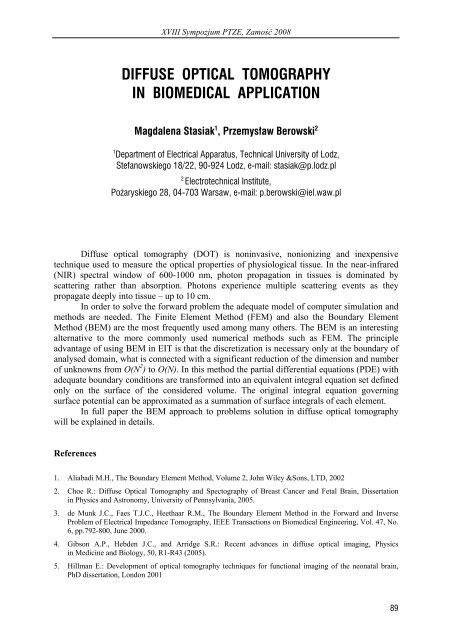zastosowania elektromagnetyzmu w nowoczesnych ... - PTZE
zastosowania elektromagnetyzmu w nowoczesnych ... - PTZE
zastosowania elektromagnetyzmu w nowoczesnych ... - PTZE
You also want an ePaper? Increase the reach of your titles
YUMPU automatically turns print PDFs into web optimized ePapers that Google loves.
XVIII Sympozjum <strong>PTZE</strong>, Zamość 2008<br />
DIFFUSE OPTICAL TOMOGRAPHY<br />
IN BIOMEDICAL APPLICATION<br />
Magdalena Stasiak 1 , Przemysław Berowski 2<br />
1<br />
Department of Electrical Apparatus, Technical University of Lodz,<br />
Stefanowskiego 18/22, 90-924 Lodz, e-mail: stasiak@p.lodz.pl<br />
2<br />
Electrotechnical Institute,<br />
Pożaryskiego 28, 04-703 Warsaw, e-mail: p.berowski@iel.waw.pl<br />
Diffuse optical tomography (DOT) is noninvasive, nonionizing and inexpensive<br />
technique used to measure the optical properties of physiological tissue. In the near-infrared<br />
(NIR) spectral window of 600-1000 nm, photon propagation in tissues is dominated by<br />
scattering rather than absorption. Photons experience multiple scattering events as they<br />
propagate deeply into tissue – up to 10 cm.<br />
In order to solve the forward problem the adequate model of computer simulation and<br />
methods are needed. The Finite Element Method (FEM) and also the Boundary Element<br />
Method (BEM) are the most frequently used among many others. The BEM is an interesting<br />
alternative to the more commonly used numerical methods such as FEM. The principle<br />
advantage of using BEM in EIT is that the discretization is necessary only at the boundary of<br />
analysed domain, what is connected with a significant reduction of the dimension and number<br />
of unknowns from O(N 2 ) to O(N). In this method the partial differential equations (PDE) with<br />
adequate boundary conditions are transformed into an equivalent integral equation set defined<br />
only on the surface of the considered volume. The original integral equation governing<br />
surface potential can be approximated as a summation of surface integrals of each element.<br />
In full paper the BEM approach to problems solution in diffuse optical tomography<br />
will be explained in details.<br />
References<br />
1. Aliabadi M.H., The Boundary Element Method, Volume 2, John Wiley &Sons, LTD, 2002<br />
2. Choe R.: Diffuse Optical Tomography and Spectography of Breast Cancer and Fetal Brain, Dissertation<br />
in Physics and Astronomy, University of Pennsylvania, 2005.<br />
3. de Munk J.C., Faes T.J.C., Heethaar R.M., The Boundary Element Method in the Forward and Inverse<br />
Problem of Electrical Impedance Tomography, IEEE Transactions on Biomedical Engineering, Vol. 47, No.<br />
6, pp.792-800, June 2000.<br />
4. Gibson A.P., Hebden J.C., and Arridge S.R.: Recent advances in diffuse optical imaging, Physics<br />
in Medicine and Biology, 50, R1-R43 (2005).<br />
5. Hillman E.: Development of optical tomography techniques for functional imaging of the neonatal brain,<br />
PhD dissertation, London 2001<br />
89




